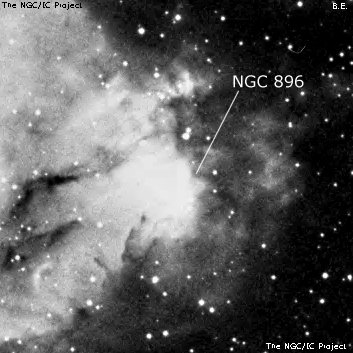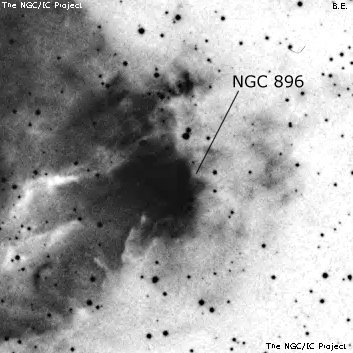NGC/IC Project Restoration Effort
(This is a very very beta version)
NGC896


Basic Information
Location and Magnitude
Right Ascension: 2:25:27.8
Declination: +62:1:10
Constellation: CAS
Visual Magnitude:
Historic Information
Discoverer: Herschel W.
Year of discovery: 1787
Discovery aperture: 18.7
Observational
Summary description: eF, pL, iF
Sub-type: EN
Corwin's Notes
=====
NGC 896. Though WH noted the polar distance as uncertain, his position is
only 4 arcmin south of the nebula, a bright knot in a huge HII ring (or
possibly a supernova remnant). In addition, CH has reduced a position with
respect to another star in the sweep (HD 24480) that is almost identical with
that derived from the offsets published in WH's PT paper (the second catalogue
of nebulae and clusters).
Wolfgang suggests that this is identical to IC 1795 (which see), found by
Barnard. I think that is unlikely as Barnard's position is close to another
knot in the same nebula. Unfortunately, Barnard's observation is apparently
one that he communicated directly to Dreyer, so we cannot easily check its
details. Until we can see that observation, I am going to assume that Barnard
(and Dreyer) knew about the proximity of the two objects and thought they were
different enough to warrant two numbers.
Steve's Notes
=====
NGC 896
18" (10/13/07): NGC 896 and IC 1795 form a bright, detailed HII region at the NW corner of the huge IC 1805 HII ring ("Heart Nebula"). This complex is split into three or 4 distinct sections by dust lanes. The largest section is IC 1795, which extends mostly north of the mag 10.3 star TYC 4050-2597-1for ~8'. To the west of the mag 10 star is a dust lane oriented NW-SE and beyond this lane to the west is a small, moderately high surface brightness patch (NGC 896) of 2' diameter. To the east of the star is another broad dust lane extending N-S and following this lane is a fainter wash of nebulosity that streams to the north for over 15' in length. It passes through mag 9 SAO 12287 and just north of this star the nebulosity has a small, brighter patch. Initially, I thought the complex ended here on the NE side, but then additional fainter nebulosity was noticed spreading out to the west for several arc minutes increasing the total size to 15'-20' for both N-S and E-W directions.
17.5" (11/27/92): at 100x with OIII filter this is a fairly bright emission nebula, very large, about 20' diameter. Elongated roughly E-W but consists of two distinct sections (NGC 896 and IC 1795) which merge together. The bright western portion = NGC 896 has a high surface brightness, round, ~7' diameter and a star is off the NW edge. A weak dark lane separates NGC 896 from faint IC 1795. The region is weakly nebulous without filter.



